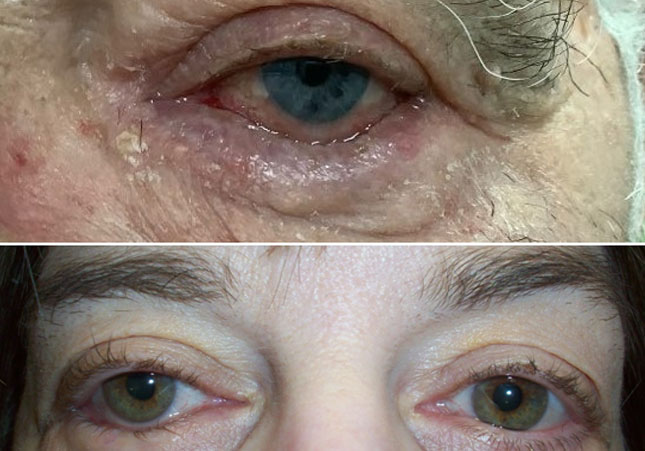Entropion Repair
Entropion Repair
As we all know, one of the common features of an aging face is the loosening of our skin. We notice this happening throughout our bodies – our torso, arms, necks, and, of course, our face. As the facial skin loosens, it is pulled downward with gravity. This pulling has a particular effect on the lower eyelid. The lower eyelid is held tightly against the eye by two tendons, one in each corner of the eye. The pulling of the facial skin stretches and lengthens these tendons, making the lower eyelid loosen. For same patients, the aging of the face also effects two separate muscles in the lower eyelid, and these muscles can slip from their normal position in the lower eyelid. If this happens, the loose lower eyelid can be turned inward. These patients will have a variety of symptoms caused by the eyelid rotating inward.
Table of Contents
Toggle
The top patient has a lower eyelid rotated inward toward the eye. The eyelashes cannot be seen as they are buried underneath the eyelid, against the eye. You can see the irritation and redness of the eye.
The bottom patient’s right lower eyelid is visibly turned inward toward the eye. Some lashes are visible but many are hidden by the rotated eyelid.
What kind of symptoms does a lower eyelid entropion produce?
The lower eyelid and the eyelashes are responsible for a number of different functions, primarily protecting the surface of the eye. When the lower eyelid turns towards the eye, the lashes begin rubbing against the eye. This can create significant irritation of the eye. It is also the job of the eyelashes to keep foreign bodies and bacteria away from the eye. When the lashes are rubbing against the eye, they create small scratches on the eye, and the bacteria that sits on the lashes may be deposited onto the eye. This can result in recurrent infections which patients may describe as constant tearing and thicker drainage from the eye. The eye is typically very red and vision can become blurry. If left untreated, some patients can develop long-standing scarring on the front surface of the eye. Therefore, entropion is a condition that should be treated quickly.
Is entropion always caused by age?
While aging is the most common cause of entropion, there are other reasons for it to occur. These include the following types of entropion:
- Age-related entropion is the most common type and occurs because of normal aging. The tendons that hold the eyelid tight loosen, causing the eyelid to sag. The muscles within the lid pull the lid inward, causing the lashes to rub against the eye.
- Scar-related entropion occurs if a patient has had previous surgery or injury to the eye or eyelid. This scarring can pull the lid toward the eye.
- Floppy eyelid syndrome is a condition that occurs because of eye rubbing and allergic illnesses. It is also strongly associated with sleep apnea. This condition causes the eyelid to stretch and become significantly looser than even age-related entropion. This looseness allows the lashes to rub against the eye. These patients’ eyelids can be so loose that they spontaneously open with minimal pressure!
How is an entropion surgery done?
Entropion repair typically involves three major parts:
- Tightening the lower eyelid
- If present, removing scar tissue
- Stitching the slipped muscles back into normal position
These steps are typically accomplished through a short surgery that we most often perform in our office. The surgery takes about 30 minutes and is done through a small incision in the outer corner of the eye. From here, Dr. Dewan can access any scar tissue and the muscles necessary to fix your entropion. We most frequently perform this surgery in our office using a local anesthetic: however, for patients with more extensive entropion, Dr. Dewan may recommend having surgery in an operating facility. This offers the ability to use sedation that will relax you for the operation.
What is the recovery like?
Patients are usually quite comfortable after entropion repair surgery. At the end of your surgery, a small bandage will be placed in the outer corner of the eye to cover the stitches. This bandage is removed the day after surgery. After the bandage is removed, antibiotic ointment will be placed on the stitches. You will likely have some bruising and swelling, so we encourage you to use ice packs for the first 2 days after surgery, followed by warm compresses for the next several days, until swelling is gone. Most patients have very little pain, and it is managed by taking Tylenol or ibuprofen. If you have eye irritation, we recommend you use artificial tears or a small dab of antibiotic ointment in the eye for a few days. There are very few restrictions on your activities after surgery, and you can drive and shower the day after surgery. The stitches typically dissolve within 10 days. Dr. Dewan will see you 1 week after surgery for a post-operative check.
Does entropion repair cause scarring?
The small eyelid incision for entropion repair falls into the natural lines of the outer corner of the eye, called “crow’s feet” or smile lines. Because the incision follows these already present lines, the incision is typically very well hidden. The skin in this location is also quite thin, so it doesn’t typically scar in a thick or visible manner. There is often a second incision made on the underside of the eyelid. This incision heals without any stitches and is not noticeable to patients.
Does insurance cover entropion repair surgery?
the best results.
